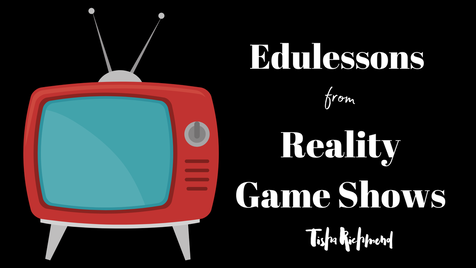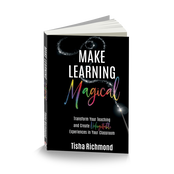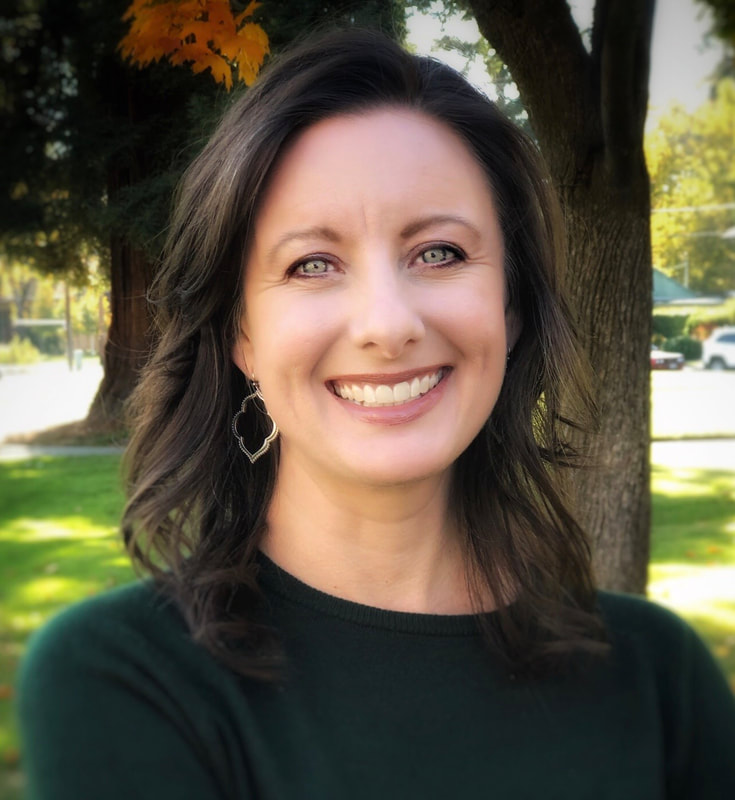 I love reality game shows. They have been a source of inspiration over the years as I have gamified classroom learning. In fact, MasterChef, The Great Food Truck Race, and The Amazing Race inspired the game frameworks that I layered over my 3 semester long culinary classes. Watching from an EDUperspective, there is a lot to be learned about rich and immersive lesson design from these shows. When we are intentional about weaving the elements together in a cohesive way, our students become empowered learners and our classrooms become places where joy and passion reside. Winter break is a perfect time for binge watching, so I decided to spend a day in my pajamas catching up on the best of reality television. I had heard quite a bit about the Netflix global cooking competition series, The Final Table, so decided to give it a watch. Right from the start, my mind started spinning with ideas. As in other reality shows that I have enjoyed, I immediately drew a parallel between the show's elements and that of the magical classroom. "The Final Table" pairs up 12 chefs from around the world to prepare global dishes. Each episode includes two challenges that highlight a specific country's cuisine. In the first challenge, each duo prepares a national dish selected by three of the countries' most celebrated ambassadors. After a short video describing the dish, the teams are given one hour to conceive, create, and plate their own version of the national delicacy. When time runs out, the three judges select their favorite of the prepared dishes and send the three lowest scoring teams to fight for their life in The Final Plate Challenge. In this second elimination round, a surprise renown chef from the highlighted country selects an ingredient native to the land. Teams must create an incredible dish from an assortment of regional ingredients and make the chosen ingredient the star. At the end of the challenge, the guest chef selects his/her favorite and determines which team’s dish is the "Final Plate" that will send them home. Let’s look at the elements in this reality television show that we can bring into classroom learning: DRAMATIC OPENING As the Final Table begins, you are drawn in by the lighting, music, and exciting introduction. Anticipation builds as the contestants are brought in and the judging panel is announced. Just as the music crescendos, the country and dish is revealed. The energy, enthusiasm, and passion of the contestants is tangible. You sense that something extraordinary is going to take place and you want to be a part of it. How you set the stage and capture an audience is important, and The Final Table does it well. They had my full attention, and I am not easily hooked! “Standing out from the crowd is the only way to guarantee your message is received in a culture that is increasingly distracted and where attention spans are plummeting.” This is no different in the classroom. As educators we are competing with many distractions that our students are bringing in to our schools each day. We must create an environment that students are drawn to. How can we create anticipation in our remote or brick and mortar classrooms? Playing dramatic music can create the mood you are wanting to achieve. Dimming the lights and focusing a spotlight on a mystery box or object of focus builds anticipation for what is to come. Creating a teaser video to draw them in, rearranging the furniture, or adding special props can add elements of curiosity and wonder. Recently reading Teach Like a Pirate by Dave Burgess, I was again reminded of the many ways we can “hook” our students to create magic in the classroom. The possibilities are truly endless! CLEAR, CONCISE EXPECTATIONS Each challenge on The Final Table starts out with clear, concise expectations. The judges are celebrated as the best chefs in the world. They have high standards and they clearly articulate what they are looking for in the executed dishes. As educators we are masters of our content. It is important that we set high standards, but also clearly articulate what we are expecting from our students. I love incorporating mystery into learning, but the standards and expectations shouldn’t be the part that is making them wonder. How are we delivering our expectations? How do we know that they understand? Both important questions to ask before the adventures in learning begin. COLLABORATION Skilled collaboration and communication are vital to the team’s success. To be able to create dishes of the highest caliber within 60 minutes, teams must work as a well-oiled machine. They must operate as a cohesive unit and clearly articulate to each other what they are doing if they are going to prepare a quality dish. I noticed contestants in The Final Table were continuously communicating and asking questions to make sure they were on the same page and working fluidly as a team. It was apparent that they knew each other’s strengths and capitalized on them. They brought out the best in each other. Without this component, disaster would surely ensue. Clearly, these teams were not just thrown together. These chefs had worked together for years. They had built a relationship and they trusted each other. As educators it is extremely important that we are creating classroom environments where relationships and trust are built. When this foundation is laid from the beginning, our students thrive. How do you build relationships and trust in your learning environment? What opportunities do you give students to collaborate and communicate? These 21st century skills are essential and we must find ways to incorporate them into our learning experiences. CRITICAL THINKING To be able to execute an outstanding dish within an hour, critical thinking is paramount. Teams have to think about how to use the ingredients to create a dish within a timeframe they are not used to operating in. They may have to adapt the methods and skills they know to be able to produce a dish with the qualities desired. Operating in a new kitchen with unfamiliar equipment and the pressure of cameras and an audience is a challenge they are not familiar with. Contestants must tap into their past experience and knowledge to meet the high standards of the judging panel. How can we create learning experiences in our classrooms that require students to think at a deeper level and reach into the recesses of their brain to solve problems? Additionally, how can we frame the learning in an exciting way where student's don’t even realize how hard they are thinking. CREATIVITY WITH CONSTRAINTS The dishes that these chefs made within a limited time frame was outstanding. Each team came with a unique set of skills and experiences that made them unique. When given the freedom to create within the constraints of time and a focused objective, they thrived. It was fascinating to watch the chefs as they quickly formulated their ideas, iterated as needed, and created beautiful masterpieces that captured the style and personality of each team. Having a focused objective and a time constraint allowed them to hone in on what they wanted to do. The most magical moments have happened in my classroom when I have created opportunities for students to create within a set of constraints. It is amazing what happens when we let their imaginations take what they know and craft in ways that express their individuality. All you have to do is look at the sparkle in their eyes to know they owned their learning and have created a memory that will remain. CALCULATED RISKS As soon as the clock started ticking, chefs began to calculate the number of risks that they needed to take to miraculously turn a combination of ingredients into something that would set their dish above the rest. They were calculating what skills & techniques they would use to produce predictable results and what risks they would take that could hopefully yield a winning outcome. The judges are evaluating the chefs for their skill, but also for their ability to innovate and create something out of the ordinary. They want to be amazed! It is important that as educators we also take calculated risks and allow our students to as well. We are continually weighing what we know works and will yield success with what is new that could improve the learning experience for our students. If we remain in our comfort zone and always go with the “sure thing” we are not only limiting ourselves, but our students as well. Magic happens when we step away from the comfort of the guaranteed and step into the realm of the unknown. The same happens for our students. If we don’t give them opportunities to take risks, they will never truly know what they are capable of. The confidence that is developed when we venture into the unknown is indescribable. Each victory gives us the courage to take another risk, and each fail gives us the fortitude to iterate and try again. What risks are you taking as an educator? Do your students feel safe to take risks and what opportunities are you giving them to take them? AUTHENTIC AUDIENCE From the very beginning, contestants know that they are going to be showcasing their skills in front of an audience of highly respected judges and a worldwide audience. This audience is not only observing the contestants throughout the challenge, they are also evaluating their finished product. When their dishes are complete, teams are explaining in detail what they created and how they prepared it. They have to be knowledgeable, articulate, and poised as they interact with the judging panel. The judge’s feedback was detailed, meaningful, and thoughtful. It was also laced with questions that would provide further clarity to the dishes’ flavors and the methods that were used to prepare it. The contestants hung on every word that was said because it was of value. They were given feedback from people they highly respected that not only indicated how well they did, but what they could improve on. That’s meaningful reflection! Something powerful happens when we are given the opportunity to share our learning with others. You could see the look of admiration on their faces when the judging panel was revealed. They were not just producing a dish for a challenge, they were creating a masterpiece for people that they revered. They had been given an opportunity to shine, and they were going to put their heart and soul into leaving a positive impression on the judges. I have found the same to be true in my own classroom. Every time we wrap up a unit, students demonstrate their learning in front of an authentic audience of staff, district employees, and local chefs. It truly is my favorite part of every unit, because students are given the opportunity to take what they learned and turn it into something extraordinary that reflects their uniqueness. Learning becomes relevant extending beyond the walls of the classroom. Not only are students given the opportunity to shine, they are receiving real and meaningful feedback from people that they respect. They are invested! They are empowered! Next time you have the control of your television remote and some time to do a little binge watching, I recommend you watch some reality television with an educational lens. I am already thinking of new challenges for the culinary classroom and how to weave this theme into another game framework. What other elements could be brought into classroom learning? How could you create similar challenges in your brick and mortar or remote classroom that focuses on the content you teach? What lessons can you learn from the comfort of your couch? Tune in and be inspired! There is a lot we can learn from reality game shows.
0 Comments
Your comment will be posted after it is approved.
Leave a Reply. |
Tisha RichmondStudent Engagement & PD Specialist in Southern Oregon, Canva Learning Consultant, Canva Education Creator, and author of Make Learning Magical. I'm passionate about finding innovative ways to transform teaching and create unforgettable experiences in the classroom. |
- HOME
- SPEAKING
- ABOUT ME
- BLOG
-
RESOURCES
- Memorable Beginnings >
- Authenticity & Agency
-
Gamified Experiences
>
- Anywhere Learning Plans
- The Amazing Race Game Plan Resources
- The Race to the Golden Ticket
- Ready Player One
- The Amazing Food Truck Race
- The Great Interior Design Challenge
- The Final Table Challenge
- Challenge Rubrics
- Challenge Ideas
- Kitchen Utensil Race & Other Variations
- Code Names for the Classroom
- Badges
- Innovation
- Creativity, Curiosity, and Collaboration
- Authentic Audience
- Legacy
- Make Learning Magical Book
- PODCAST
- T-SHIRTS
- YOUTUBE
-
RECIPES
- Workshop & Session Resources
- Dragon Smart Reviews
Proudly powered by Weebly



 RSS Feed
RSS Feed